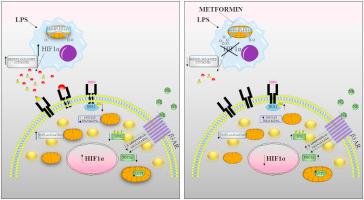Redox Biology ( IF 10.7 ) Pub Date : 2021-10-19 , DOI: 10.1016/j.redox.2021.102171 Nuria Pescador 1 , Vera Francisco 2 , Patricia Vázquez 1 , Eva María Esquinas 2 , Cristina González-Páramos 3 , M Pilar Valdecantos 1 , Irma García-Martínez 1 , Andrés A Urrutia 4 , Laura Ruiz 1 , Carmen Escalona-Garrido 1 , Marc Foretz 5 , Benoit Viollet 5 , Miguel Ángel Fernández-Moreno 3 , Alfonso L Calle-Pascual 6 , María Jesús Obregón 2 , Julián Aragonés 7 , Ángela M Valverde 1

|
Therapeutic potential of metformin in obese/diabetic patients has been associated to its ability to combat insulin resistance. However, it remains largely unknown the signaling pathways involved and whether some cell types are particularly relevant for its beneficial effects. M1-activation of macrophages by bacterial lipopolysaccharide (LPS) promotes a paracrine activation of hypoxia-inducible factor-1α (HIF1α) in brown adipocytes which reduces insulin signaling and glucose uptake, as well as β-adrenergic sensitivity. Addition of metformin to M1-polarized macrophages blunted these signs of brown adipocyte dysfunction. At the molecular level, metformin inhibits an inflammatory program executed by HIF1α in macrophages by inducing its degradation through the inhibition of mitochondrial complex I activity, thereby reducing oxygen consumption in a reactive oxygen species (ROS)-independent manner. In obese mice, metformin reduced inflammatory features in brown adipose tissue (BAT) such as macrophage infiltration, proinflammatory signaling and gene expression, and restored the response to cold exposure. In conclusion, the impact of metformin on macrophages by suppressing a HIF1α-dependent proinflammatory program is likely responsible for a secondary beneficial effect on insulin-mediated glucose uptake and β-adrenergic responses in brown adipocytes.
中文翻译:

二甲双胍可减少巨噬细胞 HIF1α 依赖性促炎症信号传导,恢复棕色脂肪细胞的体外功能
二甲双胍对肥胖/糖尿病患者的治疗潜力与其对抗胰岛素抵抗的能力有关。然而,所涉及的信号通路以及某些细胞类型是否与其有益作用特别相关,目前仍然很大程度上未知。细菌脂多糖 (LPS) 对巨噬细胞的 M1 激活促进棕色脂肪细胞中缺氧诱导因子 1α (HIF1α) 的旁分泌激活,从而减少胰岛素信号传导和葡萄糖摄取以及 β-肾上腺素能敏感性。向 M1 极化巨噬细胞中添加二甲双胍可减弱棕色脂肪细胞功能障碍的这些迹象。在分子水平上,二甲双胍通过抑制线粒体复合物 I 活性诱导 HIF1α 降解,从而抑制巨噬细胞中 HIF1α 执行的炎症程序,从而以不依赖活性氧 (ROS) 的方式减少耗氧量。在肥胖小鼠中,二甲双胍减少了棕色脂肪组织(BAT)中的炎症特征,例如巨噬细胞浸润、促炎信号传导和基因表达,并恢复了对冷暴露的反应。总之,二甲双胍通过抑制 HIF1α 依赖性促炎程序对巨噬细胞的影响可能是对棕色脂肪细胞中胰岛素介导的葡萄糖摄取和 β-肾上腺素能反应产生次要有益作用的原因。











































 京公网安备 11010802027423号
京公网安备 11010802027423号